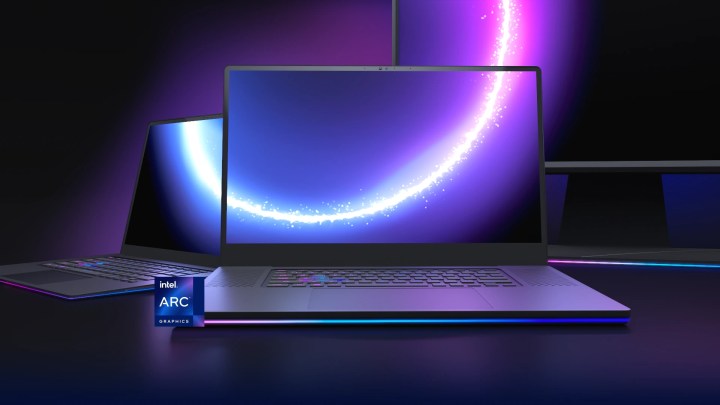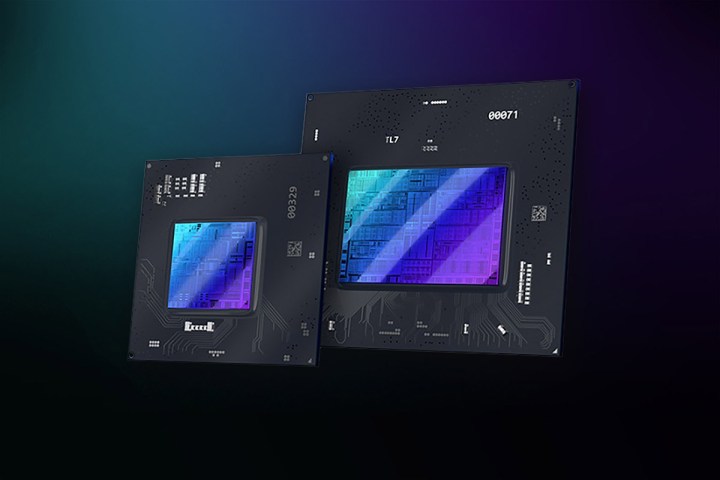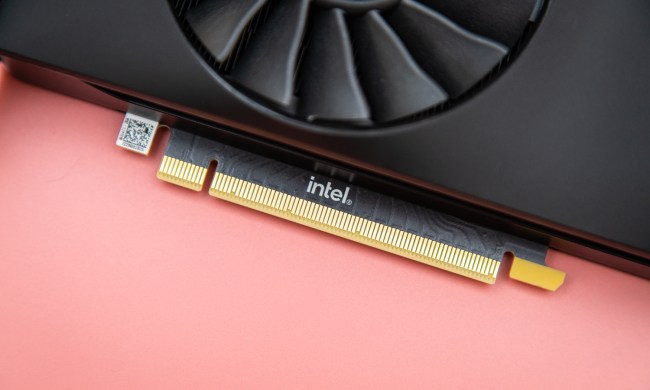Intel has released official benchmarks for its Arc Alchemist mobile graphics cards, the A730M and the A770M. Found in a reviewer’s guide, these benchmarks claim that the A730M is faster than the Nvidia GeForce RTX 3050 Ti mobile and the A770M is faster than the RTX 3060 mobile.
While that sounds great on paper, the circumstances in which these results were achieved prompt the question — can you really trust them?
Intel seems to have Nvidia beat

The Intel Arc A730M and the A770M are the crown jewels of the Arc Alchemist mobile range and are set to appear in gaming laptops globally starting this summer. The GPUs are already available in some capacity in China, which is where the benchmarks come from — they were found in a reviewer’s guide.
Both of the graphics cards feature Intel’s ACM-G10 GPU, but the A730M comes with a cut-down version, featuring 24 Xe-cores, 24 ray tracing units, 12GB of GDDR6 memory across a 192-bit memory bus, and a maximum clock speed of 1,100MHz. The A770M brings the specs up significantly, offering 32 Xe-cores and 32 ray tracing units, as well as a clock speed of up to 1,650MHz combined with 16GB of GDDR6 memory and a 256-bit bus.
Now, on to the benchmarks. Intel tested the GPUs in 17 games, mostly at high and ultra settings, in 1080p. According to these results, the A730M may be up to 13% faster than the RTX 3050 Ti Mobile and the A770M outperformed the RTX 3060M by 12%. Unfortunately, these numbers may not be entirely accurate due to the systems that were used.
The Intel Arc A730M was found in a preproduction unit, paired with a Core i7-12700H with 14 cores, as well as 16GB of DDR5-4800 RAM. However, the RTX 3050 Ti Mobile that Intel was pitted against only had a previous-gen Tiger Lake Core i7-11800H chip to accompany it, which, of course, means that DDR4-3200 RAM was used. The RTX 3050 Ti itself was also not the top version of the GPU, maxing out at 60 watts. There are 70- and 80-watt versions of the GPU, too.
The differences continue when you look at the machines used in the testing for Arc A770M versus the Nvidia GeForce RTX 3060M. The A770M has a 14-core i9-12900HK CPU, as well as 16GB of DDR5-4800 RAM, while the RTX 3060M was installed inside the MSI Pulse GL66 with a Tiger Lake Core i7-11800H CPU and 16GB of DDR4-3200 RAM. Moreover, the RTX 3060M comes in TGP variants ranging from 60 watts to 115 watts, and the one used for testing maxes out at 85 watts.
Can you really trust these results?
This brings us to the question: Can these benchmark results even be trusted? The truth is, vendor benchmarks often appear a little sketchy and there is a lot of room for skewing the results in the favor of one party. Based on what Intel showed us, it’s certain that the A730M and the A770M can compete against Nvidia, but those numbers can’t be taken at face value — if only because Nvidia’s GPUs come in many flavors, each with a different TGP and performance level. Intel matched up against a version of the RTX 3050 Ti mobile and the RTX 3060M, but neither of those was the top GPU offered by Nvidia. If they were, the results may have been different — or they could have stayed largely the same. It’s really hard to tell.
Only just yesterday, Intel served up over 20 benchmarks for the desktop Arc A380. Those results certainly redeemed the GPU a little bit after unofficial benchmarks put it in a fairly bad light, but showed how the A380 can’t even compete with the AMD Radeon RX 6400. Intel’s own benchmarks for the A380 seem to have been done in a fairer way than what we’re seeing here, though.

In the tests for the Arc A380, Intel used the same system for all three graphics cards that were being compared to one another: The A380, the Nvidia GeForce GTX 1650, and the RX 6400. This put the GPUs on an even playing ground. The same cannot be said of today’s benchmarks for the laptop-only A730M and A770M, but admittedly, it’s easier to test desktop GPUs in similar systems — all you have to do is swap out the graphics card. However, some might argue that Intel could have done a better job at picking the right sort of laptops for the rival GPUs, where the cards would have a similar TGP and the rest of the system would be on par.
It would certainly be interesting to see the flagship Intel Arc Alchemist mobile graphics cards competing against Nvidia when placed in slightly more similar systems, with full disclosure as to the power levels of both Intel and Nvidia, and compared against GPUs of a similar TGP. Until such tests emerge, it’s best to take these benchmarks (first published by Tom’s Hardware) with a bit of skepticism. After all, Intel may have already presented us with slightly optimistic benchmark results for the A380 in the past — but that has been rectified by the refreshingly honest benchmarks it delivered soon after.
That is not to say that Intel can’t be successful with the Arc Alchemist mobile lineup. The staggered China-only release is not doing the range any favors, but it’s possible that with further driver optimizations, the GPUs will begin to shine even more. Intel can also try to be competitive on pricing when it hits the global market in the summer, and that, too, could sway customers to give Arc Alchemist a try.




